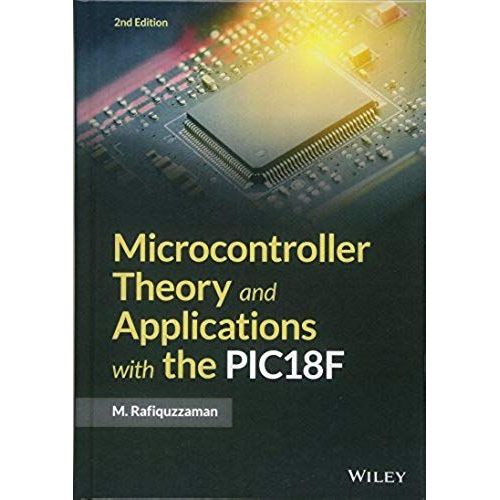

Microcontroller Theory and Applications with the Pic18f - Rafiquzzaman, M.
- Format: Relié
- 528 pages Voir le descriptif
Vous en avez un à vendre ?
Vendez-le-vôtre44,80 €
Produit Neuf
Ou 11,20 € /mois
- Livraison à 0,01 €
- Livré entre le 2 et le 5 août
- Payez directement sur Rakuten (CB, PayPal, 4xCB...)
- Récupérez le produit directement chez le vendeur
- Rakuten vous rembourse en cas de problème
Gratuit et sans engagement
Félicitations !
Nous sommes heureux de vous compter parmi nos membres du Club Rakuten !
TROUVER UN MAGASIN
Retour

Avis sur Microcontroller Theory And Applications With The Pic18f Format Relié - Livre
0 avis sur Microcontroller Theory And Applications With The Pic18f Format Relié - Livre
Donnez votre avis et cumulez 5
Les avis publiés font l'objet d'un contrôle automatisé de Rakuten.
Présentation Microcontroller Theory And Applications With The Pic18f Format Relié
- LivreAuteur(s) : Rafiquzzaman, M.Editeur : WileyLangue : AnglaisParution : 01/01/2018Format : Moyen, de 350g à 1kgNombre de pages : 528Expédition : 1100Dimensions : 18.4 x 26.0 x 3.2 ...

Résumé : Preface xiii Credits xvii 1. Introduction to Microcontrollers 1 1.1 Explanation of Terms 3 1.2 Microcontroller Data Types 7 1.2.1 Unsigned and Signed Binary Numbers 7 1.2.2 ASCII and EBCDIC Codes 10 1.2.3 Unpacked and Packed Binary-Coded-Decimal Numbers 10 1.3 Evolution of the Microcontroller 11 1.4 Embedded Controllers 14 2. Microcontroller Basics 17 2.1 Basic Blocks of a Microcomputer 17 2.1.1 System Bus 18 2.1.2 Clock Signals 19 2.2 Microcontroller architectures 20 2.3 Central Processing Unit (CPU) 21 2.3.1 Register Section 21 2.3.2 Control Unit 29 2.3.3 Arithmetic and Logic Unit (ALU) 30 2.3.4 Simplified Explanation of Control Unit design 30 2.4 Basic concept of pipelining 31 2.5 RISC vs. CISC 33 2.6 Functional Representation of a Typical Microcontroller---- The PIC18F4321 34 Questions and Problems 36 3. Microcontroller Memory and Input/Output (I/O) 37 3.1 Introduction to Microcontroller Memory 37 3.1.1 Main memory 38 3.1.2 READ and WRITE Timing Diagrams 40 3.1.3 Main Memory Organization 42 3.2 Microcontroller Input/Output (I/O) 45 3.2.1 Overview of digital output circuits 47 3.2.2 Simple I/O Devices 49 3.2.3 Programmed I/O 50 3.2.4 Unconditional and Conditional Programmed I/O 52 3.2.5 Interrupt I/O 53 Questions and Problems 56 4. Programming Languages 59 4.1 Computer Programming Languages 59 4.2 Machine Language 60 4.3 Assembly Language 60 4.3.1 Types of Assemblers 61 4.3.2 Assembler Delimiters 62 4.3.3 Specifying Numbers by Typical Assemblers 63 4.3.4 Assembler Directives or Pseudoinstructions 63 4.3.5 Assembly Language Instruction Formats 65 4.3.6 Typical Instruction Set 67 4.3.7 Typical Addressing Modes 73 4.3.8 Subroutine Calls in Assembly Language 74 4.4 High-Level Language 74 4.5 Introduction to C Language 76 4.5.1 Data types 78 4.5.2 Bit manipulation operators 79 4.5.3 Control structures 81 4.5.4 The if-else construct 81 4.5.5 The switch construct 82 4.5.6 The while construct 83 4.5.7 The for construct 84 4.5.8 The do-while construct 85 4.5.9 Structures, and Unions 85 4.5.10 Functions in C 86 4.5.11 Arrays 88 4.5.12 Macros 88 4.6 Choosing a programming language 88 4.7 Flowcharts 89 Questions and Problems 90 5. PIC18F Architecture and Addressing Modes 93 5.1 Basic features of the PIC18F family 93 5.2 PIC18F Register Architecture 96 5.3 PIC18F Memory Organization 100 5.3.1 PIC18F Program Memory 101 5.3.2 PIC18F Data Memory 101 5.4 PIC18F Addressing Modes 104 5.4.1 Literal or Immediate Addressing Mode 104 5.4.2 Inherent or Implied Addressing Mode 104 5.4.3 Direct or Absolute Addressing Mode 104 5.4.4 Indirect Addressing Mode 105 5.4.5 Relative Addressing Mode 110 5.4.6 Bit Addressing Mode 112 Questions and Problems 113 6. Assembly Language Programming With the PIC18F: Part 1 115 6.1 Introduction to the PIC18F MPLAB assembler 115 6.2 PIC18F Instruction Format 120 6.3 PIC18F Instruction Set 121 6.3.1 Data Movement Instructions 124 6.3.2 Arithmetic Instructions 130 6.3.3 Logic Instructions 138 6.3.4 Rotate Instructions 141 6.3.5 Bit Manipulation Instructions 147 Questions and Problems 151 7. Assembly Language Programming With the PIC18F: Part 2 155 7.1 PIC...
Sommaire: M. RAFIQUZZAMAN, PhD, PE, is Professor of Electrical and Computer Engineering at California State Polytechnic University, Pomona. Dr. Rafiquzzaman has over 40 years of academic and industrial experiences. He is the founder and President of Rafi Systems, Inc., a manufacturer of biomedical devices (Intraocular lenses) in California. Dr. Rafiquzzaman authored several books on digital logic, microcontrollers, and microprocessors. His first book on microprocessors was published by Wiley in 1982....
Détails de conformité du produit
Personne responsable dans l'UE
